Physical Address
304 North Cardinal St.
Dorchester Center, MA 02124
The adrenal gland is a composite of two endocrine organs, one mesodermally derived (cortex) and the other neuroectodermally derived (medulla). The function of the adrenal cortex is to secrete several steroid hormones known as corticosteroids, all of which are produced by a series of complicated enzymatic steps from cholesterol ( Fig. 29.1 ). They are classified into three groups—mineralocorticoids, glucocorticoids, and sex hormones (adrenal androgens)—depending on their biologic action. The enzymes responsible for their production can be assayed biochemically and detected immunohistochemically.
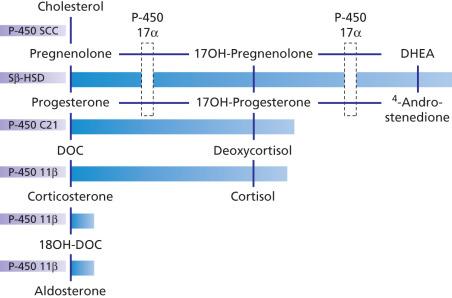
The adrenal glands are located in the retroperitoneum, superomedial to the kidneys. The combined adrenal weight in normal adult individuals should not exceed 6 g; there are no apparent sex differences.
The adrenal cortex is divided into three zones, all of which are under the influence of adrenocorticotropic hormone (ACTH): glomerulosa, fasciculata, and reticularis ( Fig. 29.2 ). The zona glomerulosa, which lies immediately beneath the capsule and is the site of mineralocorticoid (aldosterone) production, is composed of well-outlined cells aggregated into small clusters and short trabeculae. The zona fasciculata, which is the site of glucocorticoid and sex hormone production, forms a broad band made up of large cells with distinct membranes arranged in two cell-wide cords. The cytoplasm is characterized by the presence of innumerable small lipid-containing vacuoles, some of which indent the centrally located nucleus in a fashion similar to that seen in sebaceous cells and lipoblasts; these cells are sometimes referred to as spongiocytes or clear cells. The zona reticularis is also involved in the secretion of glucocorticoids and sex hormones (particularly the latter). Its cells, which are arranged in a haphazard fashion, are smaller than those in the zona fasciculata and have a cytoplasm that is granular and acidophilic, with little or no lipid (so-called compact cells). Some of these cells contain lipofuscin in their cytoplasm.
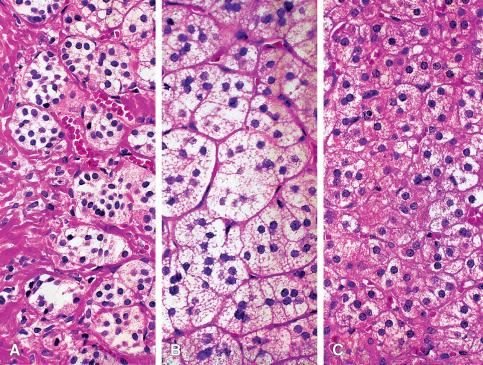
The predominant cell type in the medulla is the pheochromocyte (medullary cell or chromaffin cell), which is admixed with scattered cortical cells and ganglion cells. The pheochromocyte is a rather large cell of polygonal shape and poorly outlined borders. Its abundant cytoplasm is distinctly granular and usually basophilic, although it may be amphophilic or even eosinophilic. Occasional cells feature cytoplasmic hyaline (“colloid”) droplets, which are strongly positive with periodic acid–Schiff (PAS) stain. A second cell population of the medullary region is represented by the sustentacular cells, which are located at the periphery of the nests and trabeculae; they are difficult to identify in routinely stained preparations but are readily demonstrated by immunostaining for S-100 protein.
Ultrastructurally, the cells of the adrenal cortex share two important features that are common to all steroid-producing cells: abundant smooth endoplasmic reticulum and numerous mitochondria. The mitochondria have lamellar cristae in the zona glomerulosa and tubulovesicular cristae in the zona fasciculata and reticularis. The medullary cells can be divided into two types on the basis of the size of the cytoplasmic dense-core neurosecretory granules they contain: norepinephrine containing (electron opaque, often eccentrically located within a dilated sac, about 250 nm in diameter) and epinephrine containing (finely granular, filling the enclosing membrane, about 190 nm in diameter).
The immunohistochemical features of the cells are discussed in connection with the respective neoplasms.
The paraganglion system is formed by numerous collections of neuroepithelial cells (“chief cells”) scattered throughout the body, their common morphologic denominator being the presence of numerous cytoplasmic neurosecretory granules containing catecholamines. Microscopically, all paraganglia have a similar morphologic appearance characterized by chief cells arranged in well-defined nests (“Zellballen”) encircled by a thin layer of S-100 protein–positive sustentacular cells. The most conspicuous member of the paraganglion system is the already described adrenal medulla, a neuroeffector system connected with the orthosympathetic system. Extra-adrenal paraganglia can be divided into two broad categories: those related to the parasympathetic system (ninth, tenth, and possibly third and fifth nerves) and those connected with the orthosympathetic system. The former are usually nonchromaffin, are concentrated in the head, neck, and mediastinum, and are thought to have a chemoreceptor function. The latter are chromaffin, predominate in the retroperitoneum along the thoracolumbar para-aortic region, and probably represent lesser homologues of the adrenal medulla. Sometimes small paraganglia are found incidentally in sites such as the bladder, prostate, gallbladder, splenic capsule, and mesosigmoid ; special care should be exercised not to confuse them with foci of metastatic carcinoma ( Fig. 29.3 ).
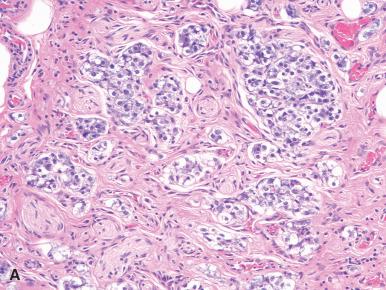
The specimens from adrenal gland received in the laboratory usually consist of the entire organ, but in selected cases the diagnosis can be achieved through the performance of an ultrasonically or computed tomography (CT)-guided biopsy or fine-needle aspiration cytology ( Fig. 29.4 ). The latter procedure is particularly useful for the diagnosis of metastatic tumors to this organ. In the series of Suen and Chan, a success rate of 86% was achieved in obtaining cellular material for diagnosis. A high rate of diagnostic accuracy for adrenal core biopsy (an overall sensitivity for malignancy of 94.6% and a specificity of 95.3%) was reported in a recently concluded multi-institutional trial of 220 consecutive patients.
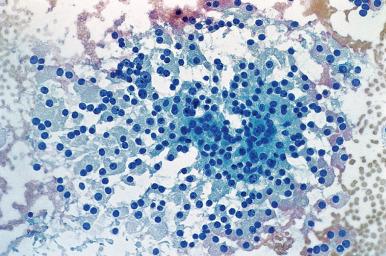
A variety of pathologic processes may arise from adrenal cortical tissue. These include malformations, heterotopias, hyperplasias, and neoplasms. Hyperplasias have been divided into clinical groups as diffuse, micronodular, and macronodular types, while neoplasms are classified as adenoma or carcinoma. Even more than in other organs, these diagnostic categories are not as discrete as might be assumed and classification based purely on histology may be impossible in a given case. The integration of the histologic and macroscopic features with endocrine findings, clinical history, and evolving molecular genetic “signatures” are likely to produce the most accurate diagnoses.
The adrenal gland may rarely have an abnormal connection to the liver or kidney. When an intervening capsule is present (without intervening fat), this is referred to as adhesion . The term union (or fusion) is used when the two tissue types are intermingled ( Fig. 29.5 ). Occasional biopsies of such lesions may be easily confused with renal cell carcinoma.
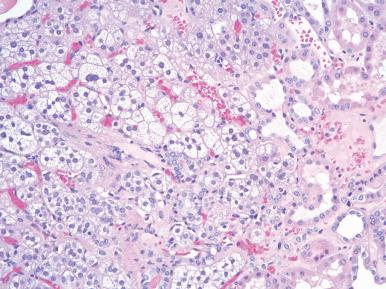
Heterotopic (accessory) adrenal cortical tissue has been reported in numerous locations, many of them resulting from some cells of the adrenocortical primordium becoming associated with and migrating alongside the gonads. The most common site is the retroperitoneal fat close to the adrenal gland. Other described sites include the region of the celiac plexus, the kidney (in an intrarenal location, to be distinguished from renal–adrenal fusion ), along the course of the spermatic and ovarian veins, the testis, adjacent to the tail of the epididymis, the broad ligament near the ovary, the ovary itself (but only exceptionally), the canal of Nuck, hernial and hydrocele sacs, the mesoappendix, and the liver. It has also been rarely reported in distant sites such as lung, intradural space, and brain. The epididymis associated with the ectopic adrenal tissue may show various types of malformation. The ectopic cortical tissue is almost never accompanied by a medullary component.
These ectopic nests may undergo marked hyperplasia in patients with Nelson syndrome or other conditions associated with increased ACTH production, and they occasionally give rise to ectopic adrenal cortical adenomas and carcinomas.
Congenital adrenal hyperplasia, an inborn error of metabolism, is a family of autosomal recessive disorders that produce defects in adrenal steroid production. It is responsible for the large majority of cases of adrenogenital syndrome developing within the first year of life, but it can also first present clinically during adulthood. Specific symptoms and their severity are variable, depending on the specific mutation, the residual enzyme activity, and the sex of the patient.
In approximately 95% of the cases, the defect is an absence of the enzyme 21-hydroxylase, which results in the accumulation of 17OH-progesterone and its catabolite pregnanetriol and in a deficiency of cortisol. The clinical picture may include pure virilizing syndrome, electrolyte disturbances (e.g. “salt losing” forms), or more mild symptoms. The second most frequent form is due to a deficiency of 11β-hydroxylase and is characterized by virilization and hypertension. Several other variants, all exceptionally rare, have been described, including 17OH deficiency, 3 βHSD2 deficiency, P540 oxidoreductase deficiency, lipoid congenital adrenal hyperplasia ( STAR mutation), and P540 cholesterol side chain cleavage enzyme deficiency. The specific genes encoding each of the steroid biosynthetic enzymes have been cloned, and the common mutations (and their variants) in these genes are being determined. The most important of these is the CYP21A2 gene on chromosome 6p21.3, but over 100 separate mutations are reported even in this most common form. The pathologic change is the same in all types and is characterized by diffuse cortical hyperplasia, especially of the zona reticularis. The treatment consists predominantly of hormone replacement, but a balance of measures to address normal development and later psychosocial, sexual, and fertility issues may be challenging. The testicular “tumors” occurring in patients with adrenal cortical hyperplasia are discussed in Chapter 27 .
This morphologically distinct form of adrenal hyperplasia (sometimes referred to as “micronodular adrenal disease”) may be isolated or a component of Carney complex and is characterized by ACTH-independent Cushing syndrome typically in younger age groups. The adrenal glands, which may be small, normal sized, or slightly enlarged, show multiple pigmented cortical nodules with atrophy of the intervening cortex. These nodules are primarily composed of eosinophilic, lipid-poor cells similar to those of the normal zona reticularis, and many cells contain lipofuscin/neuromelanin pigment ( Fig. 29.6 ). The cells show intense immunoreactivity for all the steroidogenic enzymes. Occasional additional features include microscopic foci of necrosis, mitoses, and a trabecular pattern of growth. Some patients have germline mutations in PRKAR1A . Although rare, this etiology should be carefully considered in children who present with Cushing disease. Other similar hyperplasias are rarely seen in patients with PDE11A or PDE8B mutations.
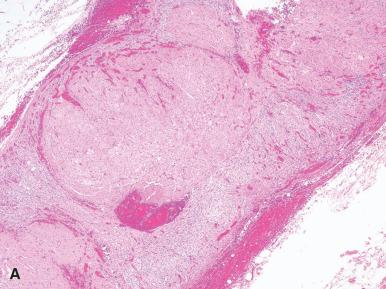
Acquired hyperplasia, which is always bilateral, may result in a diffuse or a nodular (“adenomatous” or “adenomatoid”) enlargement of the adrenal gland ( Fig. 29.7 ). An adrenal gland in an adult can be regarded as hyperplastic if it weighs over 6 g, provided that a careful dissection of the fat has been carried out. Most cases of diffuse cortical hyperplasia are due to ACTH hyperproduction by either the pituitary gland or an ACTH-producing neoplasm in the lung or some other organ. Thus they are referred to as ACTH dependent or—in the former instance—pituitary dependent. In some cases, however, the pathogenesis remains obscure.
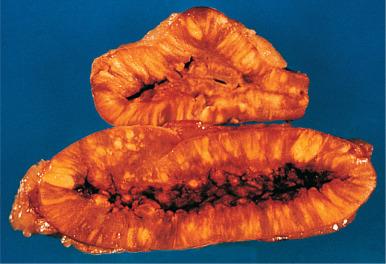
Grossly, the cortical zone of the adrenal appears thickened. Microscopically, an increased thickness of the zona reticularis and fasciculata is observed, the relative proportions varying from case to case. Occasionally, cells with large hyperchromatic nuclei are seen in some of the nodules. Many of the cells in the fasciculata layer appear compact and lipid depleted. Ultrastructurally, these cells have abundant smooth endoplasmic reticulum and long microvilli that interdigitate with the microvilli of adjacent cells. Flow cytometric and image analysis studies have shown the presence of aneuploid and polyploid cell populations.
Most cases of macronodular cortical hyperplasia , which are unrelated to ACTH production and are therefore referred to as ACTH independent or adrenal dependent, present with Cushing syndorme. In some instances, they may represent a later stage of diffuse hyperplasia, in which the lesion has undergone a transition from pituitary dependent to adrenal dependent. The bilateral adrenal glands can become massively enlarged, mimicking a neoplasm, and the cortex between cortical nodules is commonly atrophic. A rare subset of cases presents in children and may be associated with McCune–Albright syndrome ( GNAS mutation). Recent studies suggest the presence of germline or somatic mutations in ARMC5, particularly in cortisol secreting forms of the disease.
Traditionally, adrenocortical neoplasms have been divided into adenomas and carcinomas. Many tumors can be easily placed into one category or another, but there is an intermediate (“borderline”) group for which the distinction is difficult and to some extent arbitrary (further discussed in the differential diagnosis section).
Adrenal cortical adenomas represent the most common primary adrenal lesion seen in routine diagnostic practice. They may be functioning (producing aldosterone, cortisol, or sex hormones) or nonfunctioning. These are either detected by symptoms of a hormonal secretory product with subsequent identification on CT scan or incidentally at the time of imaging for other reasons.
Grossly, adenomas are usually solitary. Adenomas are characteristically small, rarely exceeding 5 cm in greatest diameter or 50 g in weight. Adenomas are well circumscribed and typically encapsulated. The cut surface of an adenoma usually has a solid homogeneous yellow to tan appearance ( Fig. 29.8 ). Larger tumors may have areas of central hemorrhage.
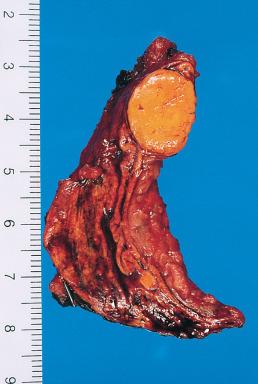
Microscopically, the adenomas may recapitulate the appearance of the zona fasciculata, the zona glomerulosa, or, more commonly, a combination of both ( Fig. 29.9 ). Prototypically, the cells are clear to lightly eosinophilic and are filled with small lipid vacuoles. The cells are often organized in nests or cords that are associated with a rich capillary vasculature or sinusoidal network. Occasional bizarre nuclear forms can be seen, as in most other endocrine neoplasms. However, mitoses are exceptionally rare or absent . Morphologic variants of adrenocortical adenomas include:
Adrenocortical adenoma containing foci of myelolipoma are reported but are of no clinical consequence.
Black adenoma . Occasionally, adenomas (as well as hyperplastic nodules) have a dark brown to black color because of the presence of pigment, representing either lipofuscin or rarely neuromelanin. Most of these “black adenomas” or “black nodules” are nonfunctioning and found incidentally at autopsy, but on occasion they have been associated with primary aldosteronism or Cushing syndrome. These nodules have a higher radiologic density than the ordinary yellow cortical tumors.
Adrenocortical oncocytic adenoma (oncocytoma). This is a neoplasm in which the tumor cells are packed with mitochondria ( Fig. 29.10 ). Both benign (i.e. oncocytoma) and malignant forms exist, the former predominating. Most are nonfunctioning. Interestingly, at the ultrastructural level the mitochondria retain the tubulovesicular cristae that are typical of steroid-producing cells, and they may also contain peculiar cytoplasmic crystalline inclusions. The typical prognostic features used to distinguish adenoma from carcinoma are not optimized for oncocytic tumors, so modified classifications have been adopted (see differential diagnosis later and Box 29.1 ).
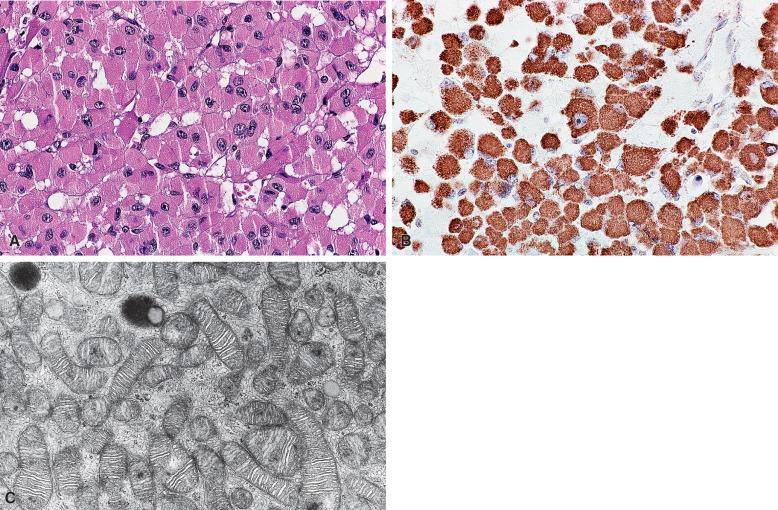
a The presence of ≥3 of these criteria correlates with malignant potential.
Tumor necrosis
Mitotic rate >5 mitoses per 50 high-power fields
Atypical mitoses
High nuclear grade (Fuhrman criteria for grade III or IV)
Diffuse architecture
<25% clear cells
Invasion of venous structures
Invasion of sinusoidal structures
Invasion through the capsule
Myxoid adrenocortical neoplasms. Adrenocortical adenomas can rarely have prominent myxoid stroma. Myxoid tumors seem to behave more aggressively than would be predicted by the Weiss criteria; therefore, the diagnosis of myxoid adrenocortical adenoma should be made with extreme caution.
Lipoadenoma. Cases have been reported of adrenocortical adenomas (as well as nodular cortical hyperplasias) containing abundant mature adipose tissue.
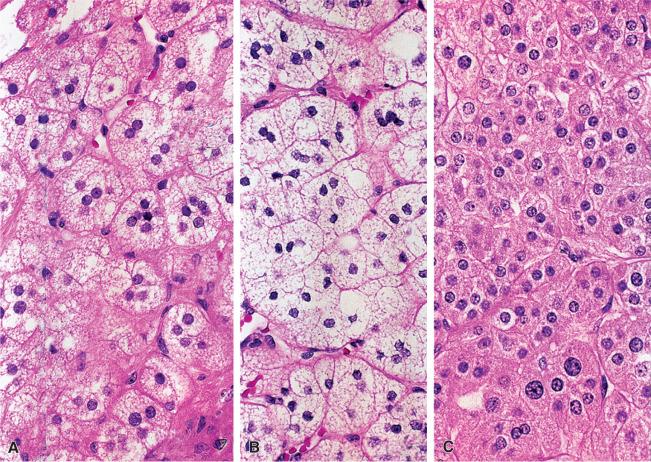
Whereas instances of cortical hyperplasia and adenomas are found commonly at post mortem examination of asymptomatic individuals, most of the nonfunctioning adrenal cortical lesions seen in the past as surgical specimens were carcinomas. This has changed markedly since the advent of ultrasonography, CT, and magnetic resonance imaging, which have allowed the detection of a large number of benign asymptomatic adrenocortical adenomas.
In primary aldosteronism (Conn syndrome), the excessive amount of secreted aldosterone results in urinary loss of potassium, retention of sodium, suppressed renin levels, hypertension, and muscle weakness.
Microscopically, one would expect these adenomas to have an appearance similar to that of the zona glomerulosa, since this is the area in which aldosterone is produced in the normal adrenal gland. Although this is sometimes the case, most of the tumor cells resemble those of the zona fasciculata or have characteristics intermediate between zona glomerulosa and zona fasciculata cells (so-called hybrid cells). The zona glomerulosa of the nontumoral gland is normal, hyperplastic, or atrophic. In patients who have been treated with spironolactone, a characteristic cytoplasmic structure may appear in the tumor cells, as well as in the cells of the adjacent zona glomerulosa. It is a whorled, multilaminar collection of membranes, as large as 20 µm in diameter, and is thought to derive from the smooth endoplasmic reticulum ( Fig. 29.11 ). Typical evaluation of a patient suspected of having primary aldosteronism includes pharmacologic exploration of the renin–angiotensin–aldosterone system and radiographic examination of the adrenal glands to distinguish primary aldosteronism from cases of renovascular and essential hypertension.
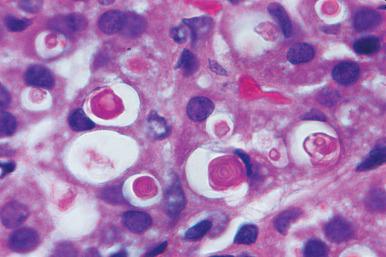
Become a Clinical Tree membership for Full access and enjoy Unlimited articles
If you are a member. Log in here